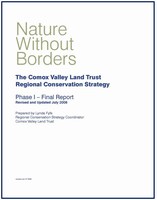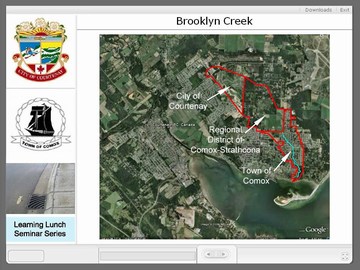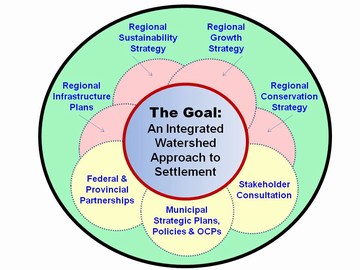Nature Without Borders: Align Efforts at a Watershed Scale in the Comox Valley
Note to Reader:
Green infrastructure and water sustainability — the Comox Valley is demonstrating what can be achieved through a ‘regional team approach’ that is striving for consistency at local government front counters. This is accomplished through sharing of experiences, collaboration, alignment, and pooling of resources to ‘achieve more with less’.
At the 2011 Comox Valley Learning Seminar Series, the spotlight is on the unfunded ‘infrastructure liability’ confronting all local governments. This is a driver for a change in the way local governments plan, finance, implement and over time replace infrastructure.
The article below foreshadows what to expect when Jack Minard and Kevin Lorette speak to the following theme at the second in the 2011 Series: Nature Without Borders: Align Efforts at a Watershed Scale in the Comox Valley. To download a PDF document version of the article, click here.
Sustainable Service Delivery links land use planning, watershed health and ‘infrastructure liability’
Sustainable Service Delivery is the Province’s term of choice for an holistic approach to infrastructure asset management. It involves a life-cycle way of thinking about infrastructure needs and how to pay for those needs over time. Moreover, the linkage to protection of a community’s natural resources is an important piece in Sustainable Service Delivery.
One of the foundation pieces underpinning the program for the 2011 Comox Valley Seminar Series is this: All those involved in land development have a role to play in achieving Sustainable Service Delivery.
Seminar #2 Overview
In April, Seminar #1 painted a picture of the ‘legacy liability’ of existing hard infrastructure (i.e. roads, water, sewers). On May 19, Seminar #2 will deal with green infrastructure and how it enables ‘sustainable urban drainage’ at a lower life-cycle cost.
The Seminar #2 spotlight is on urban watershed protection and restoration issues, with emphasis on a ‘design with nature’ approach to climate change adaptation. A desired outcome is that participants will understand how a ‘design with nature’ approach to implementation of green infrastructure integrates rainwater management and drought management.
LEARN MORE: To download a copy of the Agenda for Seminar #2, click on Adaptation – Design with Nature to Achieve Rainfall Capture and Water Conservation Goals
Nature Without Borders
Released in July 2008, Nature Without Borders is the title of a report that lays out a community vision. Initiated by the Comox Valley Land Trust, the Comox Valley Regional Conservation Strategy is a long-term approach to use and conservation of land. The Strategy aims to assist in wise and informed land use decisions and conservation actions.
 “Nature has no borders; it does not recognize political or philosophical boundaries and it is essential for the health of human and non-human communities alike,” states Jack Minard, Executive Director of the Comox Valley Land Trust. “To view nature in this way represents not a ‘special interest’ approach but a modern advance in civil society. We are realizing that the current loss of ecosystems and biodiversity cannot continue, yet pressures to develop land for human use are placing huge demands on what remains.”
“Nature has no borders; it does not recognize political or philosophical boundaries and it is essential for the health of human and non-human communities alike,” states Jack Minard, Executive Director of the Comox Valley Land Trust. “To view nature in this way represents not a ‘special interest’ approach but a modern advance in civil society. We are realizing that the current loss of ecosystems and biodiversity cannot continue, yet pressures to develop land for human use are placing huge demands on what remains.”
Align Efforts at a Watershed Scale
Jack Minard and Kevin Lorette (Comox Valley Regional District) will provide community and local government perspectives, respectively, in setting the context for the day. Their co-presentation will:
- Refresh the vision for An Integrated Watershed Approach to Settlement.
- Introduce the Tsolum River case study that will be featured in Seminar #3.
- Connect the dots between land development practices and water balance management.
- Provide a segue to the “course within a seminar” that Jim Dumont will deliver.
“The story of Brooklyn Creek that Glenn Westendorp will be referencing in his opening  remarks will provide the springboard for Kevin and my co-presentation,” states Jack Minard. “The Brooklyn Creek experience epitomizes how stripping away the water storage capacity of the watershed landscape impacts on stream health in two ways: loss of baseflow…that is, too little water in dry weather; and channel instability and erosion…that is, too much water for too long during wet weather.”
remarks will provide the springboard for Kevin and my co-presentation,” states Jack Minard. “The Brooklyn Creek experience epitomizes how stripping away the water storage capacity of the watershed landscape impacts on stream health in two ways: loss of baseflow…that is, too little water in dry weather; and channel instability and erosion…that is, too much water for too long during wet weather.”
“Alignment of efforts at a watershed scale is a way of thinking that is weaved into the storyline for the 2011 Series,” continues Kevin Lorette, General Manager of Property  Services with the Comox Valley Regional District. “Each seminar kicks off with a context presentation that speaks to this message. At Seminar #1, Jack Minard and Nancy Hofer connected the dots to the Comox Valley Developers Dialogue that was held in December 2010. At Seminar #2, Jack and I will take a couple of minutes to describe what align efforts at a watershed scale means to us in practical terms.”
Services with the Comox Valley Regional District. “Each seminar kicks off with a context presentation that speaks to this message. At Seminar #1, Jack Minard and Nancy Hofer connected the dots to the Comox Valley Developers Dialogue that was held in December 2010. At Seminar #2, Jack and I will take a couple of minutes to describe what align efforts at a watershed scale means to us in practical terms.”
TO LEARN MORE: Click on Brooklyn Creek established a precedent for inter-municipal collaboration to resolve drainage issues in the Comox Valley

Look Beyond Our Municipal Boundaries
Seminar #2 is structured in two parts. In the morning, the unifying theme is “Look Beyond Our Municipal Boundaries”. The focus is on aligning efforts at a watershed scale to ‘design with nature’, protect stream stability, and save money.
In the afternoon, the theme is “Look Within Our Municipal Boundaries” because the spotlight shifts to the Northeast Comox case study and implementation of green infrastructure to achieve a ‘lighter water footprint’.

An Integrated Watershed Approach to Settlement
“Everyone is so busy in their jobs such that it is a challenge to assimilate multiple plans and initiatives that are underway at a regional scale in the Comox Valley. To provide focus and clarity regarding the desired outcome of the 2009 Seminar Series, we defined the goal of a regional team approach to be An Integrated Watershed Approach to Settlement,” explains Kevin Lorette.
“To help stakeholders conceptualize what a vision for balance and integration would look like, we then created a branding graphic (see below). This shows the elements that must ultimately be integrated to achieve the goal of An Integrated Watershed Approach to Settlement.”
“The ultimate goal of the regional team approach is to maximize the intersection of the elements. This means creating linkages among the different areas of action, thereby helping to create a stronger implementation plan – that is, what all the plans will achieve,” concludes Kevin Lorette. 
Posted May 2011



